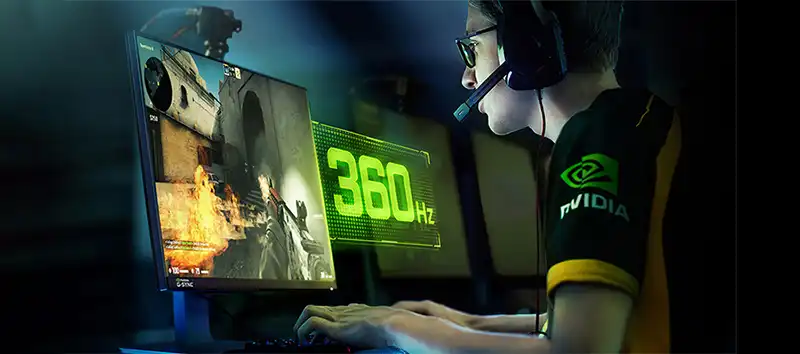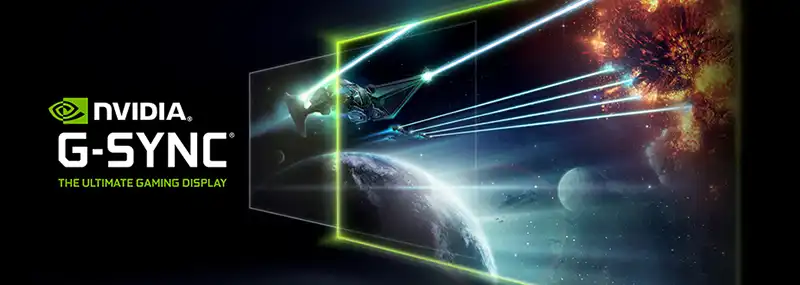You can also be interested in these:
- What is Nvidia GeForce Now?
- The Nvidia Deep Learning Super Sampling (DLSS) technology
- ViewSonic VX2458 gaming monitor review
- ViewSonic Elite XG271QG gaming monitor review
Nvidia’s G-Sync technology is a game-changer for PC gaming. By synchronizing the refresh rate of the monitor with the frame rate of the GPU, G-Sync eliminates screen tearing and stuttering for a smoother, more fluid gaming experience.
G-Sync also reduces input lag, making games more responsive and giving players a competitive edge. Best of all, G-Sync works with any monitor or TV that supports HDMI 1.4 or DisplayPort 1.2. If you’re serious about PC gaming, G-Sync is a must-have technology. Learn more about how G-Sync works and why it’s such a big deal for gamers.

What is Nvidia G-Sync?
G-Sync is a technology developed by Nvidia that eliminates screen tearing and stuttering in PC games. By synchronizing the refresh rate of the monitor with the frame rate of the GPU, Nvidia G-Sync ensures that each frame is displayed for the exact amount of time it is supposed to be. This results in a smoother, more fluid gaming experience.
In addition to eliminating screen tearing, G-Sync also reduces input lag. This means that games are more responsive, and players have a competitive edge. Nvidia G-Sync is available on any monitor or TV that supports HDMI 1.4 or DisplayPort 1.2. This makes it one of the most widely compatible gaming technologies on the market.
Why is G-Sync important in gaming?
G-Sync is important for two main reasons: it eliminates screen tearing and reduces input lag. Screen tearing is a common issue that affects gamers. It occurs when the frame rate of the GPU is not in sync with the refresh rate of the monitor. This results in visible artifacts on the screen, which can be distracting and disrupt gameplay.
Nvidia G-Sync solves this problem by synchronizing the refresh rate of the monitor with the frame rate of the GPU. This ensures that each frame is displayed for the exact amount of time it is supposed to be, eliminating screen tearing.

Input lag is another common issue faced by gamers. It occurs when there is a delay between the time a player presses a button and the time that action is displayed on the screen. This can make games feel unresponsive and can put players at a disadvantage.
G-Sync reduces input lag by synchronizing the refresh rate of the monitor with the frame rate of the GPU. This eliminates the need for the graphics card to wait for the monitor to refresh, resulting in a more responsive gaming experience.
How Does G-Sync Work?
G-Sync works by synchronizing the refresh rate of the monitor with the frame rate of the GPU. This ensures that each frame is displayed for the exact amount of time it is supposed to be, eliminating screen tearing and reducing input lag.
G-Sync accomplishes this by using a dedicated chip that is built into the monitor. This chip communicates with the GPU in order to sync the refresh rate of the monitor with the frame rate of the GPU. The result is a smoother, more fluid gaming experience with reduced input lag.
What are the benefits of using Nvidia G-Sync over other technologies like V-Sync or FreeSync?
Nvidia G-Sync is a proprietary adaptive sync technology developed by Nvidia. It was introduced in 2013 and has since been incorporated into many gaming monitors. The key benefits of G-Sync over other technologies like V-Sync or AMD’s FreeSync are its ability to reduce screen tearing, stuttering, and input lag. G-Sync also results in a smoother and more responsive gaming experience overall.
Some of the other advantages of using G-Sync include HDR compatibility, variable refresh rate (VRR) support, and low framerate compensation (LFC). VRR allows the monitor to adjust its refresh rate to match the frame rate of the graphics card, which can help to eliminate screen tearing.
LFC is a feature that allows the monitor to maintain a consistent framerate even when the graphics card is unable to maintain a constant frame rate. This can be helpful in situations where the game is running at a lower framerate than the monitor’s maximum refresh rate.
HDR compatibility is another key selling point of G-Sync. HDR monitors are becoming increasingly popular, and G-Sync provides an added level of compatibility with these displays. This means that gamers can enjoy the benefits of HDR without having to worry about screen tearing or stuttering.
Overall, Nvidia G-Sync is an excellent technology for gamers who want the best possible gaming experience. It eliminates many of the common issues associated with other types of sync technologies, and its additional features make it an ideal choice for gamers who want the most out of their gaming experience.
If you’re a gamer who wants the best possible gaming experience, then Nvidia G-Sync is the way to go. There’s no need to worry about screen tearing or stuttering, and the added benefits of HDR compatibility and low framerate compensation make it an ideal choice for gamers who want the most out of their gaming experience.
What kind of monitors support Nvidia G-Sync and what are the requirements for your graphics card and motherboard?
In order to use Nvidia G-Sync, you will need a compatible monitor and graphics card. Monitors that support Nvidia G-Sync come in a variety of sizes and resolutions. However, all G-Sync monitors must have a DisplayPort connection in order to work. Many G-Sync monitors also support HDR, which can further improve the gaming experience.

In terms of graphics cards, any Nvidia GPU that supports DisplayPort 1.2 or higher will work with G-Sync. This includes all of Nvidia’s GeForce GTX 900 and 1000 series cards, as well as the RTX 20 series. Motherboards are not a requirement for G-Sync, but your graphics card will need to be connected to your monitor via a DisplayPort cable. If you’re using an HDMI cable, G-Sync will not work.
So, if you’re looking to get the most out of your gaming experience, make sure you have a monitor that supports Nvidia G-Sync. And, if you don’t have a compatible graphics card, consider upgrading to one of Nvidia’s latest models. With G-Sync, you’ll be able to enjoy smoother and more responsive gaming, as well as reduced screen tearing and input lag.
Are there any downsides to using Nvidia G-Sync, or is it a completely seamless experience across all games and applications?
However, there are a few potential downsides to using Nvidia G-Sync. Firstly, it requires a specialized monitor that supports the technology. These monitors tend to be more expensive than standard ones. Additionally, G-Sync can introduce a small amount of input lag, which may be noticeable to some gamers.
Finally, G-Sync only works with Nvidia GPUs, so if you have an AMD GPU, you won’t be able to take advantage of the technology. Overall, though, Nvidia G-Sync is a great technology that can significantly improve your gaming experience.
How to troubleshoot any problems you may be having with Nvidia G-Sync
If you’re having problems with Nvidia G-Sync, there are a few things you can do to troubleshoot the issue. First, make sure that your monitor is compatible with G-Sync. Check the list of supported monitors on Nvidia’s website.
If your monitor is compatible, then the next step is to check for any updates to your graphics driver. You can do this by going to the ‘Display Driver’ tab in the Nvidia Control Panel. If there is an update available, download and install it.
If you’re still having problems, try resetting your graphics card settings to their defaults. This can be done in the ‘3D Settings’ tab in the Nvidia Control Panel. Once you’ve reset your settings, try enabling G-Sync again.
If you’re still having problems, then the next step is to contact Nvidia customer support. They will be able to help you further troubleshoot the issue.
How to set up Nvidia G-Sync on your computer
If you’re a PC gamer, there’s a good chance you’re using an NVIDIA graphics card. And if you’re using an NVIDIA graphics card, there’s a good chance you’re interested in getting the most out of your gaming experience. One of the best ways to do that is to enable G-Sync.
G-Sync is a technology that syncs your monitor’s refresh rate with your graphics card’s frame rate. This can help reduce screen tearing and input lag, and it can make your games look and feel smoother overall.
If you’re not already using G-Sync, here’s how to set it up on your computer:
- Make sure you have an NVIDIA graphics card. G-Sync is only available on NVIDIA graphics cards.
- Connect your monitor to your graphics card using a DisplayPort cable. G-Sync is not compatible with HDMI, so you’ll need to use a DisplayPort cable.
- Open the NVIDIA Control Panel. You can do this by right-clicking on your desktop and selecting “NVIDIA Control Panel” from the menu.
- Click on “Display.”
- Under the “Advanced Settings” section, click on “Monitor Technology.”
- Select “G-Sync Compatible” from the drop-down menu and click “Apply.”
- Restart your computer for the changes to take effect.
That’s all there is to it. Once you’ve followed these steps, G-Sync will be enabled on your computer and you’ll start seeing the benefits right away.
Is G-Sync worth it?
Absolutely. If you’re serious about PC gaming, G-Sync is a must-have technology. The smooth, fluid gameplay and reduced input lag it provides gives players a competitive edge.
Additionally, G-Sync is one of the most widely compatible gaming technologies on the market. It works with any monitor or TV that supports HDMI 1.4 or DisplayPort 1.2. So, if you’re looking for a way to improve your gaming experience, G-Sync is the way to go.
Conclusion
Nvidia G-Sync is an important technology that can provide a much better gaming experience for users. By understanding how it works and the benefits of using it, you can make an informed decision about whether or not to use it on your own computer. We hope this article has been helpful in explaining what G-Sync is and why it’s so important.
More stories like this
- What is Nvidia GeForce Now?
- The Nvidia Deep Learning Super Sampling (DLSS) technology
- ViewSonic VX2458 gaming monitor review
- ViewSonic Elite XG271QG gaming monitor review
- Yeyian Sigurd 4000 gaming monitor review
- KTC M27P20P 4K Mini-LED gaming monitor review
